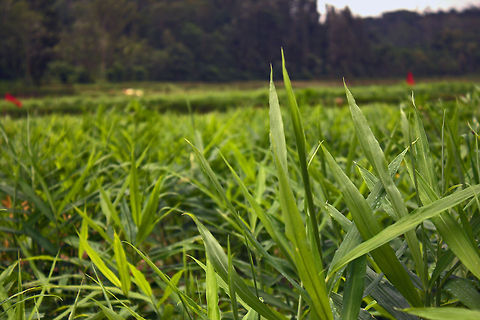
Naming
Mid-14c., from Old English gingifer, from Medieval Latin gingiber, from Latin zingiberi, from Greek zingiberis, from Prakrit singabera, from Sanskrit srngaveram, from srngam "horn" + vera- "body," so called from the shape of its root. But this may be Sanskrit folk etymology, and the word may be from an ancient Dravidian name that also produced the Tamil name for the spice, inchi-ver, from inchi "root." Cf. gin . The word apparently was readopted in Middle English from Old French gingibre .Uses
Ginger produces a hot, fragrant kitchen spice. Young ginger rhizomes are juicy and fleshy with a very mild taste. They are often pickled in vinegar or sherry as a snack or just cooked as an ingredient in many dishes. They can also be steeped in boiling water to make ginger tea, to which honey is often added; sliced orange or lemon fruit may also be added. Ginger can also be made into candy, or ginger wine which has been made commercially since 1740.Mature ginger rhizomes are fibrous and nearly dry. The juice from old ginger roots is extremely potent and is often used as a spice in Indian recipes, and is a quintessential ingredient of Chinese, Korean, Japanese, Vietnamese and many South Asian cuisines for flavoring dishes such as seafood or goat meat and vegetarian cuisine.
Ginger acts as a useful food preservative.
Fresh ginger can be substituted for ground ginger at a ratio of 6 to 1, although the flavors of fresh and dried ginger are somewhat different. Powdered dry ginger root is typically used as a flavoring for recipes such as gingerbread, cookies, crackers and cakes, ginger ale, and ginger beer.
Candied ginger, or crystallized ginger, is the root cooked in sugar until soft, and is a type of confectionery.
Fresh ginger may be peeled before eating. For longer-term storage, the ginger can be placed in a plastic bag and refrigerated or frozen.
Cultural
Ginger produces clusters of white and pink flower buds that bloom into yellow flowers. Because of its aesthetic appeal and the adaptation of the plant to warm climates, ginger is often used as landscaping around subtropical homes. It is a perennial reed-like plant with annual leafy stems, about a meter tall.Traditionally, the rhizome is gathered when the stalk withers; it is immediately scalded, or washed and scraped, to kill it and prevent sprouting. The fragrant perisperm of Zingiberaceae is used as sweetmeats by Bantu, also as a condiment and sialogogue.
References:
Some text fragments are auto parsed from Wikipedia.